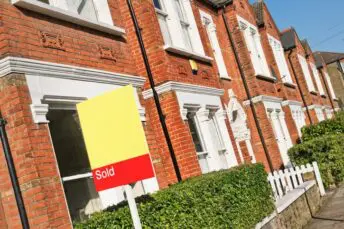House Price Watch Dec 2022
House prices fall again in December and the annual rate of growth slows sharply. Cost of living increases alongside rising interest rates, is leading to an overall slowing of the market. Affordability is a key factor as we move into 2023 given higher mortgage rates and house prices still higher than they were at the start of 2022. As a result, a slower period for house prices is expected. Though the outlook is extremely uncertain, an adjustment in prices rather than a sharp fall is expected. We would expect house prices to fall by up to 5% in 2023 (still above pre-pandemic levels).
What’s happening nationally
House prices are down on average -0.6% in the past month and annual house price growth has slowed to +5.0%.
Indices reporting on December house prices indicate a significant slowing of the annual rate of house price growth. It is important to look at the individual indices as Land Registry figures lag others.
Indices based on:
Land Registry – registered property transactions in November.
Nationwide & Halifax – mortgage valuations in December.
Rightmove – asking prices posted on Rightmove in December.
*Rightmove is not included in the index average as the basis for its index is different (asking price vs agreed sale price)
| Index reports: | Monthly change | Annual change |
|---|---|---|
| Land registry | -0.3% | +10.3% |
| Nationwide | -0.1% | +2.8% |
| Halifax | -1.5% | +2.0% |
| Rightmove | -2.1% | +5.6% |
| Average change | -0.6% | +5.0% |
House prices in your area
Most areas in the UK experienced a fall in house prices over the past month. The biggest declines were in Wales (-1.6%), Scotland (-1.2%) and the North East of England (-2.6%).
Average house prices are highest in London (£542K) and lowest in the North East (£163K).
House price growth varies by property type. Detached (+10.6%), semi detached (11.3%) and terraced (12.0%) homes have seen the biggest rise and flats/ maisonettes the smallest (+5.7%) according to November Land Registry data.
| UK Region | Average price £ | Monthly change | Annual change |
|---|---|---|---|
| England | |||
| Nothern Ireland | |||
| Scotland | |||
| Wales | |||
| North West | |||
| Yorkshire and The Humber | |||
| North East | |||
| West Midlands | |||
| East Midlands | |||
| South West | |||
| East of England | |||
| South East | |||
| London |
| UK City | Average price | Annual change |
|---|---|---|
Market Monitor
There were 107K transactions in November, steady with October 2022 and 13% higher than November 2021. Note that transactions were unusually low in the last quarter of 2021 because of the end of the final stamp duty holiday in September. 107K transactions is slightly above the usual level for this time of year based on recent years.
Demand continues to fall as do new instructions from sellers. Stock of homes for sale falls.
Time to sell slows further in December.
How busy is the market?
- Not busy
- Normal
- Very busy
- Transactions steady month on month and slightly higher than is typical this time of year.
- Total transactions in November 107K
- no change from last month
- +13% from November last year (unusually low transactions with end of stamp duty holiday in Sept last year)
Homes for sale vs homebuyers
- Good availability of homes
- Normal
- Shortage of homes
- Buyer enquiries continue to fall (-38% RICS); seventh monthly drop
- Seller enquiries down (-9% RICS)
- Average stock per agent 43; down from 48 last month (incl under offer/ Sold STC Rightmove)
Average speed of sale
- Fast
- Normal
- Slow
- 52 days to find a buyer up from 45 days (12 month average 38 days Rightmove)
What the experts say
Rightmove

“Though we would always expect prices to drop in December, as motivated sellers try to capture the attention of a buyer before Christmas with a competitive price, this monthly dip is the largest we’ve seen for four years. It‘s an understandable short-term reaction to the economic turmoil and unexpectedly rapid mortgage rate rises and reduction in availability of mortgage products that we saw in late September and October, before things began to settle down. After two and a half years of frenetic activity it’s easy to forget that having multiple bidders immediately lining up to buy your home was the exception rather than the norm in pre-pandemic years, and there will be a period of readjustment for home-movers as properties take longer to find the right buyer. We’re heading towards a more even balance between supply and demand next year, but we don’t expect a surge in forced sales which would cause a glut of properties for sale and contribute to more significant price falls in 2023. This is reflected in our prediction of a relatively modest average fall of 2% next year.”
Nationwide

“December marked the fourth consecutive monthly price fall – the worst run since 2008. While financial market conditions have settled, mortgage rates are taking longer to normalise and activity in the housing market has shown few signs of recovery. While house prices are likely to see a modest decline in 2023 (perhaps of c.5%), a significant deterioration in the labour market or more elevated mortgage rates would probably be required to generate the double-digit declines suggested by some forecasters. While the risks are skewed in that direction, it doesn’t appear to be the most likely outcome.”
Halifax

“As we’ve seen over the past few months, uncertainties about the extent to which cost of living increases will impact household bills, alongside rising interest rates, is leading to an overall slowing of the market. The cost of the average home remains high – greater than it was at the start of 2022 and over 11% more than house prices at the beginning of 2021. As we enter 2023, the housing market will continue to be impacted by the wider economic environment and, as buyers and sellers remain cautious, we expect there will be a reduction in both supply and demand overall, with house prices forecast to fall around 8% over the course of the year. It’s important to recognise that a drop of 8% would mean the cost of the average property returning to April 2021 prices, significantly above pre-pandemic levels.”
Zoopla (Hometrack)

“Affordability is the primary factor looking ahead to 2023 and beyond influenced by mortgage rates, household incomes and the actual level of house prices. The more unaffordable a market, the more households are priced out, weakening demand and impacting sales volumes and pricing. The opposite is true in affordable markets with lower average house prices. We expect house price growth to slow in these higher-growth markets in 2023. Our national view is UK house prices falling by 5% next year. Price falls in more affordable markets are likely to be below average as the hit to buying power from higher mortgage rates will be less than in the high-value markets.”




